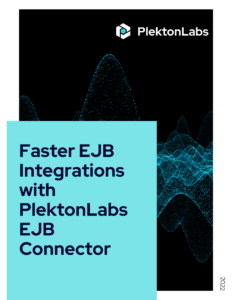While businesses and organizations everywhere are upgrading their tech, some kinds of legacy systems show no signs of going away any time soon. Enterprise JavaBeans or EJB is one such piece of tech that may seem outdated with the rise of APIs but is still commonly used by over 23500 companies across the world. And this means that an EJB connector is a necessity for all these organizations.
Let’s break it down. We’ll be looking at Enterprise JavaBeans, the issues they pose, and what EJB connectors can do to mitigate the situation.
EJB is a communication protocol that allows applications to communicate with each other. In other words, it is a server-side software element that encloses the business logic of a particular application.
So far, so good. But if this were the case, EJBs would be way more popular at the moment.
The Issue with EJBs
The way that EJBs function at the moment in different integration technologies is through manually written EJB protocol codes. This means someone in IT has to sit down and enter all the necessary codes from scratch by hand. The downside of this isn’t just the sheer time that it takes. Besides being time-consuming, the process also uses up manpower and resources that could be put to better use elsewhere.
At the same time, manual codes are prone to errors. Any mistakes made will take hours to correct and can cost companies lots of time and money.
The solution to all this? There is a way to use EJBs while bypassing the need to write hours’ worth of code to keep them up and running. And an EJB Connector makes this happen.
EJB Connectors to the Rescue
When a business uses an EJB connector like the PlektonLabs EJB connector v1.0, they don’t have to manually code. This saves time and allows organizations to reallocate their manpower and resources where they will be more useful.
This creates an uptick in productivity and efficiency within the business. In addition, there are way fewer chances of any errors happening, which saves costs in the long run. Developers in the IT team no longer need to spend hours writing or testing code or correcting any mistakes.
Other benefits include simplifying the overall development and testing stages. In other words, an EJB connector can modernize legacy systems. It resolves issues faced by older systems or databases that happen to use the EJB protocol.
Why Choose the PlektonLabs EJB Connector?
Up until very recently, there weren’t any EJB connectors, so developers had no choice but to write the code for the EJB protocol themselves.
However, the PlektonLabs EJB connector allows communication between your Mule app and the Enterprise JavaBeans. It can work with both EJB 3.0 and EJB 2.0 versions. It can be used with JBOSS and Web Logic servers for these versions
Also, the PlektonLabs EJB connector can only work on systems using MuleSoft 4.2.X. The PlektonLabs EJB connector will link a Mule app to an EJB server so that it can retrieve data from the server.
The user first has to configure the connector based on the server information. Moreover, they need to add the Weblogic/Jboss driver with the EJB Service package. Depending on the kind of server, the user needs to configure the server properties used to construct the initial Context.
Being the only EJB connector on the market at the moment, it will give developers and businesses the following advantages:
Saving Time
In the past, developers had to write long pieces of the code themselves, however long it took. The EJB connector prevents the need for writing manual code, saving time and resources. Companies can use the time and manpower saved and spend them where they are needed the most.
Shortening Development Time
Besides removing the necessity for writing hours’ worth of code, this tool shortens development and testing by a third of the usual time.
Fewer Chances of Human Error
When developers spend hours writing code themselves, there is a chance that they can make mistakes, which then takes a long time to correct. The EJB connector reduces the chances of these errors.
Reduces Overall Costs
In addition to saving time and resources and cutting down the chances of human error, this tool significantly saves costs involving development and testing.
Wrapping Up
Businesses that rely on older tech are often left behind in the race to modernize legacy systems. The PlektonLabs EJB connector offers these older systems a way to function more efficiently, saving time, money, and resources. For developers struggling to grapple with lengthy code, this connector can make the process much easier, changing the way they interact with these older systems.




